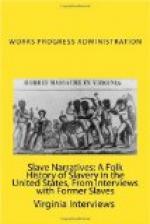Dr. Buckner stated that officials thought Jacob entirely too aged to enter the service as he had a few scattered white hairs but he remembers he was brawny and unafraid. Isaac was too young but the other two uncles were accepted. One never returned because he was killed in battle but one fought throughout the war and was never wounded. He remembers how the white men were indignant because the negroes were allowed to enlist and how Mars Stanton Buckner was forced to hide out in the woods for many months because he had met slave Frank Buckner and had tried to kill him. Frank returned to Greensburg, forgave his master and procurred a paper stating that he was at fault, after which Stanton returned to active service. “Yes, the road has been long. Memory brings back those days and the love of my mother is still real to me, God bless her!”
Relating to the value of an education Dr. Buckner hopes every Caucassian and Afro-American youth and maiden will strive to attain great heights. His first efforts to procure knowledge consisted of reciting A.B.S.s [TR: A.B.C.s?] from the McGuffy’s [HW: ?] Blue backed speller with his unlettered sister for a teacher. In later years he attended a school conducted by the Freemen’s Association. He bought a grammar from a white school boy and studied it at home. When sixteen years of age he was employed to teach negro children and grieves to recall how limited his ability was bound to have been. “When a father considers sending his son or daughter to school, today, he orders catalogues, consults his friends and considers the location and surroundings and the advice of those who have patronized the different schools. He finally decides upon the school that promises the boy or girl the most attractive and comfortable surroundings. When I taught the African children I boarded with an old man whose cabin was filled with his own family. I climbed a ladder leading from the cabin into a dark uncomfortable loft where a comfort and a straw bed were my only conveniences.”
Leaving Greensburg the young mulatto made his way to Indianapolis where he became acquainted with the first educated Negro he had ever met. The Negro was Robert Bruce Bagby, then principal of the only school for Negroes in Indianapolis. “The same old building is standing there today that housed Bagby’s institution then,” he declares.
Dr. Buckner recalls that when he left Bagby’s school he was so low financially he had to procure a position in a private residence as house boy. This position was followed by many jobs of serving tables at hotels and eating houses, of any and all kinds. While engaged in that work he met Colonel Albert Johnson and his lovely wife, both natives of Arkansas and he remembers their congratulations when they learned that he was striving for an education. They advised his entering an educational institution at Terre Haute. His desire had been to enter that institution of Normal Training but felt doubtful of succeeding in the advanced courses taught because his advantages had been so limited, but Mrs. Johnson told him that “God gives his talents to the different species and he would love and protect the negro boy.”




